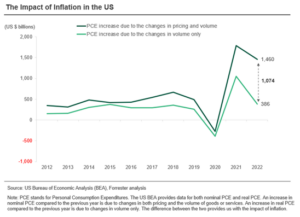One Trillion Dollars: The Cost Of Inflation In The US In 2022
Inflation has been highly discussed in the US throughout 2022, with news articles and earnings calls highlighting its impact on consumer spending. As we entered 2023, we asked ourselves, how much more did US consumers spend due to increased prices in 2022? Our analysis shows that:
In 2022, US consumers spent an extra $1 trillion due to increased prices.
How do we know this? We analyzed personal consumption expenditures (PCE) data provided by the US Bureau of Economic Analysis (BEA). The BEA provides the data for nominal PCE and real PCE.
An increase in nominal PCE compared to previous years is due to changes in both pricing and the volume of goods or services. An increase in real PCE compared to the previous year is due to changes in volume only. In the graphic below, “The Impact of Inflation in the US,” we see that:
- In 2022, nominal PCE spending increased to $17.4 trillion, up from $15.9 trillion in 2021. Real PCE spending rose to $14.1 trillion, up from $13.7 trillion in 2021.
- As such, nominal PCE spending increased by $1.5 trillion in 2022 (again, reflecting both pricing and volumes) while real PCE spending increased by only $0.4 trillion (reflecting volume only).
- The difference between the two — $1.1 trillion — is what US consumers paid extra due to increased prices alone. This figure is over five times the average amount that consumers paid more due to increased prices in pre-COVID years.

What Did US Consumers Spend That Money On?
Looking at the BEA PCE spending data by category in 2022, US consumers spent nearly one-third of the total PCE spend of $17.4 trillion on goods and the remaining two-thirds on services. Goods spending increased from $5.5 trillion in 2021 to $5.9 trillion in 2022, while services spending increased from $10.4 trillion in 2021 to $11.4 trillion in 2022.
The BEA breaks down goods into durable versus nondurable goods. Durable goods have a shelf life of three years or more. In 2022, US consumers spent nearly one-third of the total goods spend on durable goods and the rest on nondurable goods.
Here’s the impact of inflation across different PCE categories:
- Goods versus services. Of the $1.1 trillion that US consumers spent extra due to increased prices in 2022, US consumers paid $468 billion extra due to increased prices of goods and $636 billion extra due to increased prices of services.
- Durable goods versus nondurable goods. In 2022, nondurable goods overall became more expensive than durable goods. US consumers spent $335 billion more due to increased prices of nondurable goods and $133 billion more on durable goods.
- Nondurable goods. The impact of inflation was very evident in the categories of gasoline, food, and beverages. US consumers paid $121 billion more due to increased prices of gasoline and other energy goods in 2022. Plus, US consumers paid nearly the same amount extra due to increased prices of food and beverages (please see “The Impact of Inflation by Category in the US in 2022” chart below).
- Durable goods. Motor vehicles and parts as well as furnishings and durable household equipment saw the largest increase in prices, with US consumers paying $72 billion and $46 billion extra, respectively, for these two categories alone. Recreational goods and vehicles saw deflation. The prices of televisions, other video equipment, and information processing equipment declined instead of increasing. Spending growth in these categories was volume-driven, not inflation-driven.
- Services. In the services category, US consumers spent $636 billion more due to increased prices, with housing and utilities, food services and accommodations, health care, transportation services, and recreation services seeing the most significant impact.

Forrester can provide further insights on the growth of US consumer spending in different categories during pre-COVID years and from 2020 to 2022, as well as the dollar and percentage impact of inflation in different categories. If you’re a Forrester client, please schedule an inquiry or guidance session with me to learn more.
